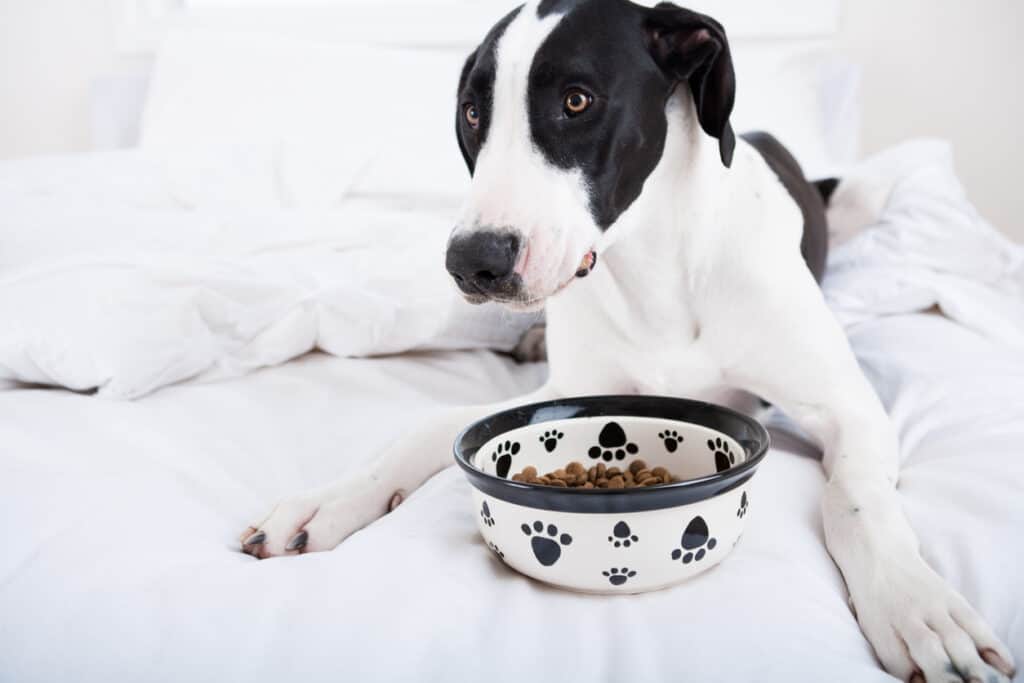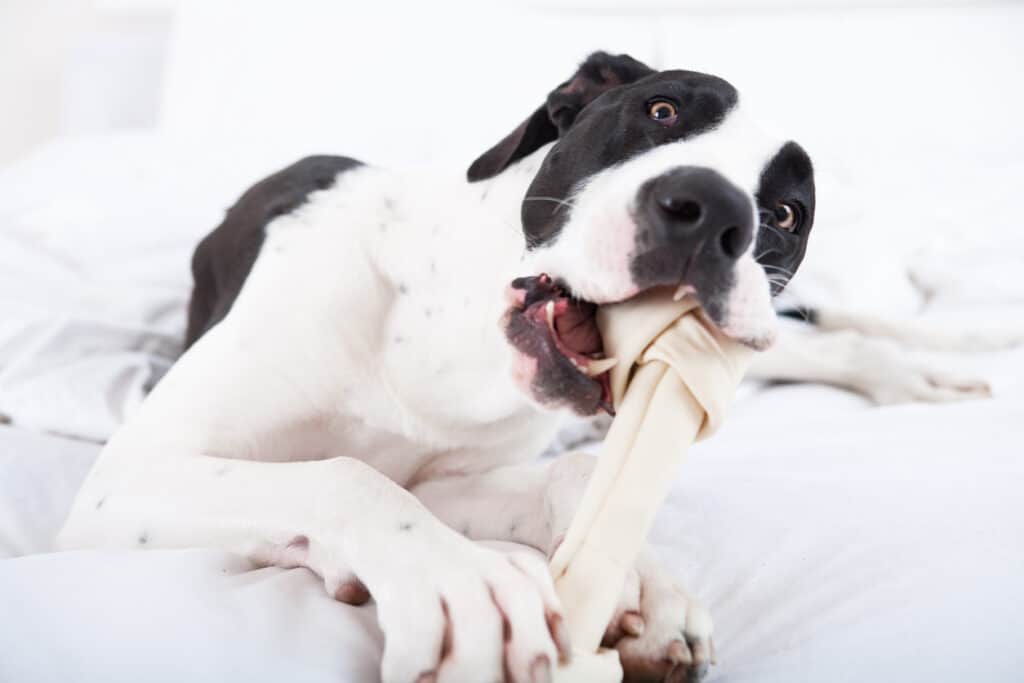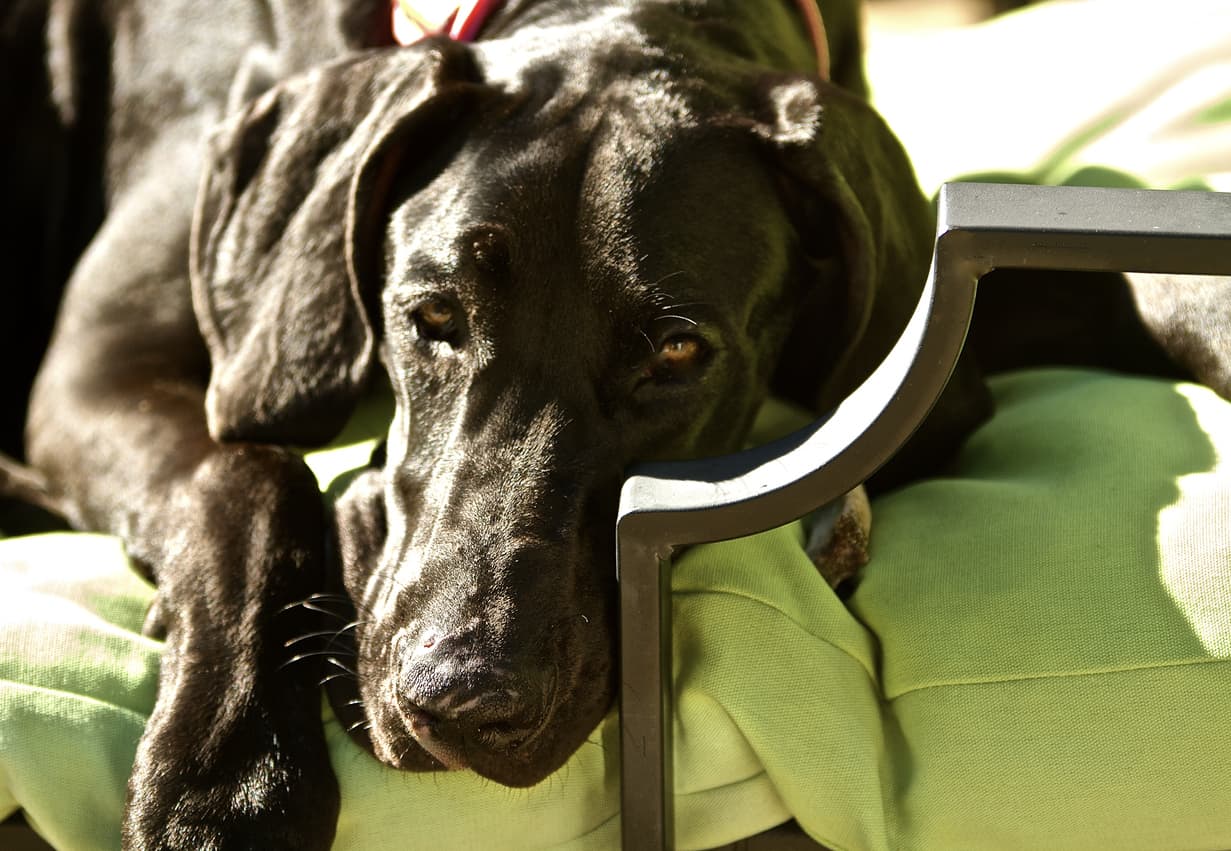Great Dane bloat is one of the most frightening things that can happen to an owner. This painful medical condition requiring immediate veterinary attention is most likely to affect large and giant breeds. Great Danes are, unfortunately, prime candidates to develop this condition due to their huge size and deep, narrow chest. However, having a physical predisposition to bloat does not take into account the many other factors that can stack up against a Great Dane and cause it to develop bloat –there are also genetic and environmental factors to consider.

Bloat is the colloquial term for Gastric Dilatation-Volvulus (GDV). It is one of the most common health ailments that occurs in Great Danes and is caused when too much air or gas gets trapped in the stomach, causing it to become very distended and put pressure on other internal organs.
While extremely painful and dangerous to the health of the dog, the real fear associated with bloat (aka GDV) is torsion. Torsion is when the buildup of gas places so much pressure on the stomach that it flips on its axis and cuts off circulation and blood flow to critical organs.
While bloat is fairly easy to diagnose with the naked eye, the fact is that a distended stomach could also signal a multitude of serious health issues. If you suspect that your Great Dane may be bloating, it’s imperative to seek emergency veterinary care.
As previously mentioned, the Great Dane is at particular risk of developing bloat and torsion due to a variety of factors including confirmation, genetics, and environmental. Other large and giant breeds such as Mastiffs, Standard Poodles, and German Shorthair Pointers (among many others) also fall into the high-risk category where bloat is concerned, but the fact is, any dog can develop bloat.
In the case of the Great Dane, a significant percentage of these dogs will develop bloat each year, which is something owners must bear in mind when deciding to add a Great Dane to the family. Even in the best-case scenario, a case of bloat will require an emergency trip to the vet, X-rays, and some sort of medical intervention which will easily cost somewhere in the neighborhood of $1000.
Causes of bloat

Bloat is known to occur when too much air or gas becomes trapped in the stomach. However, the factors that lead too much air or gas to become trapped in the stomach remain somewhat of a mystery due to the variety of factors that can cause the condition to develop.
In addition to a confirmation that predisposes them to developing bloat, is has also been found that fearful Great Danes are more likely to develop bloat. Fear is typically correlated with stress levels, so it’s imperatives that Great Dane owners be aware of and seek to minimize stressful conditions for their Great Dane.
Reducing stressful and fearful conditions can be done in a variety of ways but is best approached proactively from the moment a Great Dane puppy enters a home. While the importance of thorough and ongoing socialization is often espoused as a necessity with regard to raising a well-mannered and obedient Great Dane, the benefits of socialization also extend to the longevity of your Great Dane too. A well-socialized Great Dane will be a calmer, happier dog than one that is not.
In addition to ensuring your Great Dane puppy is properly socialized, it’s important to provide Great Danes with the best quality food. Great Danes have unique dietary needs both as puppies and as adults due to the amount of time it takes for them to reach their full adult size and proportions (about three years). Studies have shown that the risk of bloat decreases fourfold when soybean meat and fat are not listed in the first four ingredients of dog food. Indeed, raw and homemade meals seem to suit Great Danes best, with several studies finding reduced cases of bloat in Great Danes that receives such personalized meals.
If seeking out quality raw food or making your Great Dane homemade meals sounds like an expensive endeavor to you, just remember: committing to a Great Dane means committing to well over $20,000 in care over the course of its lifetime, which on average is seven to ten years. This is not a budget-friendly breed.
It is generally agreed that another factor that may influence the occurrence of bloat is exercise. Too much or too intense of an exercise or play session immediately after eating is thought to increase the risk of bloat. Additionally, too much water before or after has been traditionally thought to increase the risk.
One disputed factor with regard to Great Dane bloat is raised feeders. Because research is available to support both opinions on this controversial topic, it’s advised for Great Dane owners to approach the decision with an open mind and do their own research, consult with their veterinarian, and observe their Great Dane to see whether they exhibit any preferences for raised feeders or not when eating or drinking.
How to identify bloat
Because of the ever-present risk that a Great Dane may develop bloat, it’s important for owners to be aware of the symptoms of bloat. Symptoms of bloat in Great Danes include the following:
- Distended stomach that is hard to the touch and feels like a basketball when you tap it
- Pacing and general restlessness
- Heavy panting
- Retching, inability to vomit
- Clear discomfort
- Thick, foamy drool (much different from the usual stringy types)
- Rapid heart rate
- Pale gums/capillaries (this could be due to decreased blood flow)
- Collapse/loss of consciousness
Responses
First and foremost, it’s important for owners to stay calm. If you have done your research and have a care response plan in place before you suspect your Great Dane may be bloating, you can respond confidently and without fear. When your Great Dane comes to you and is exhibiting symptoms consistent with those seen in Gastric Dilatation-Volvulus (aka bloat), it is going to need reassurance and immediate action from you.
For all owners, the first step in a care response plan for a case of suspected bloat should be to call their veterinarian or emergency veterinary hospital and let them know that you will be bringing in a Great Dane with a suspected case of bloat and torsion.
After this first step, some Great Dane owners recommend administering gas-relief pills such as Phazyme to their Great Dane, which is an over-the-counter pill available to humans. This is not a step that should be taken without significant background research and veterinary consultation due to the risk of administering oral medication to an animal that is having severe stomach issues. Additionally, it’s important to remember that these pills should never be seen as a replacement for veterinary care, only as a means of relieving some of your Great Dane’s discomfort and buy time in an extremely time-sensitive situation while you drive to the vet clinic.
How to prevent bloat

While it’s impossible to prevent bloat, one of the most proactive steps owners can take is to familiarize themselves with the symptoms of bloat and develop a care-response plan prior to needing one. There are also several other things for Great Dane owners to consider when it comes to mitigating their Great Dane’s risk of bloat.
If and when you decide to neuter or spay your Great Dane puppy, your veterinarian may recommend adding a gastropexy procedure (commonly referred to as a “pexy”) while the animal is already under anesthesia. This procedure is designed for breeds that are at an increased risk of developing bloat and involves stapling the inner stomach lining to the abdominal wall so that the stomach cannot flip during a severe bloat. The procedure is not recommended for intact Great Danes.
Providing a few small meals throughout the day instead of one or two large meals has been scientifically proven to reduce cases of bloat in Great Danes. Small meals combined with careful selection of the type of food your Great Dane ingests will go a long way in ensuring the long-term health of your Great Dane. Certain ingredients such as soybean meal and fat should not appear in the first four ingredients listed on the nutrition chart of your Dane’s food.
While socialization plays a key role in the development and expression of a puppy’s personality, it’s also on owners to cultivate an environment that reflects the needs of their Great Danes personality. Hyperactive Great Danes (though rare) are at an increased risk of developing bloat, as are fearful and unhappy Danes. Great Danes are not born fearful and unhappy, therefore, these factors may be directly mitigated by providing Great Danes with appropriate and thorough socialization and exposure to many different experiences throughout its life.
Training techniques can also play a factor in whether Great Danes become fearful or unhappy. As a highly sensitive breed, Great Danes respond best to positive training and desensitization techniques.
Finally, genetics and breeding practices also play a role in the prevention of bloat in Great Danes. Studies have shown that if an immediate relation has developed bloat, the Great Dane in question is more likely to bloat. In theory, Great Danes that have a history of bloating should be prevented from reproducing, but given the prevalence of bloating in the breed, this standard may be difficult to adhere to.
Costs associated with bloat treatment
As previously discussed, Great Danes are an expensive breed to own. A case of bloat always requires an immediate trip to the vet, and if surgery is necessary then the cost will likely be between $3000-$5000. Although the results of these surgeries have vastly improved over the years, there remains a not-insignificant statistical chance that your Great Dane will pass away during or after, leaving you emotionally and financially spent.
The bottom line
Great Danes make wonderful family pets and owners will tell you they are well worth the investment in time and money, despite their short lifespans. However, because of their short life spans and the financial resources necessary to properly provide for them, prospective owners should seriously consider whether they are truly prepared to care for “the Apollo of Dogs.” If you are able to answer in the affirmative, it’s time to take action by researching and educating yourself and any family or friends who will also be responsible for the care of your Great Dane on its needs.
Below is a great video that concisely shows a veterinarian’s response to bloat, as well as an explanation of the appropriate course of actionBloat in a dog. How to diagnose GDV, and why an acutely distended abdomen might be an emergency. Co – YouTube

